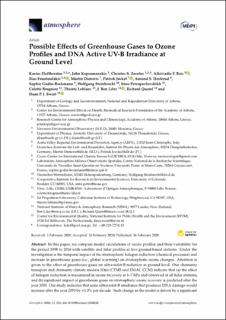| dc.contributor.author | Eleftheratos, Kostas | |
| dc.contributor.author | Kapsomenakis, John | |
| dc.contributor.author | Zerefos, Christos S. | |
| dc.contributor.author | Bais, Alkiviadis F. | |
| dc.contributor.author | Fountoulakis, Ilias | |
| dc.contributor.author | Dameris, Martin | |
| dc.contributor.author | Jöckel, Patrick | |
| dc.contributor.author | Haslerud, Amund Søvde | |
| dc.contributor.author | Godin-Beekmann, Sophie | |
| dc.contributor.author | Steinbrecht, Wolfgang | |
| dc.contributor.author | Petropavlovskikh, Irina | |
| dc.contributor.author | Brogniez, Colette | |
| dc.contributor.author | Leblanc, Thierry | |
| dc.contributor.author | Liley, J. Ben | |
| dc.contributor.author | Querel, Richard | |
| dc.contributor.author | Swart, Daan P.J. | |
| dc.date.accessioned | 2021-07-14T12:16:52Z | |
| dc.date.available | 2021-07-14T12:16:52Z | |
| dc.date.created | 2020-07-21T11:14:22Z | |
| dc.date.issued | 2020 | |
| dc.identifier.citation | Atmosphere. 2020, 11 (3), . | en_US |
| dc.identifier.issn | 2073-4433 | |
| dc.identifier.uri | https://hdl.handle.net/11250/2764424 | |
| dc.description.abstract | In this paper, we compare model calculations of ozone profiles and their variability for the period 1998 to 2016 with satellite and lidar profiles at five ground-based stations. Under the investigation is the temporal impact of the stratospheric halogen reduction (chemical processes) and increase in greenhouse gases (i.e., global warming) on stratospheric ozone changes. Attention is given to the effect of greenhouse gases on ultraviolet-B radiation at ground level. Our chemistry transport and chemistry climate models (Oslo CTM3 and EMAC CCM) indicate that (a) the effect of halogen reduction is maximized in ozone recovery at 1–7 hPa and observed at all lidar stations; and (b) significant impact of greenhouse gases on stratospheric ozone recovery is predicted after the year 2050. Our study indicates that solar ultraviolet-B irradiance that produces DNA damage would increase after the year 2050 by +1.3% per decade. Such change in the model is driven by a significant decrease in cloud cover due to the evolution of greenhouse gases in the future and an insignificant trend in total ozone. If our estimates prove to be true, then it is likely that the process of climate change will overwhelm the effect of ozone recovery on UV-B irradiance in midlatitudes. | en_US |
| dc.language.iso | eng | en_US |
| dc.publisher | MPDI | en_US |
| dc.rights | Navngivelse 4.0 Internasjonal | * |
| dc.rights.uri | http://creativecommons.org/licenses/by/4.0/deed.no | * |
| dc.subject | ozone | en_US |
| dc.subject | UV-B irradiance | en_US |
| dc.subject | halogens | en_US |
| dc.subject | greenhouse gases | en_US |
| dc.subject | effects | en_US |
| dc.title | Possible Effects of Greenhouse Gases to Ozone Profiles and DNA Active UV-B Irradiance at Ground Level | en_US |
| dc.type | Journal article | en_US |
| dc.type | Peer reviewed | en_US |
| dc.description.version | publishedVersion | en_US |
| dc.source.pagenumber | 0 | en_US |
| dc.source.volume | 11 | en_US |
| dc.source.journal | Atmosphere | en_US |
| dc.source.issue | 3 | en_US |
| dc.identifier.doi | 10.3390/atmos11030228 | |
| dc.identifier.cristin | 1819997 | |
| cristin.ispublished | true | |
| cristin.fulltext | original | |
| cristin.qualitycode | 1 | |

